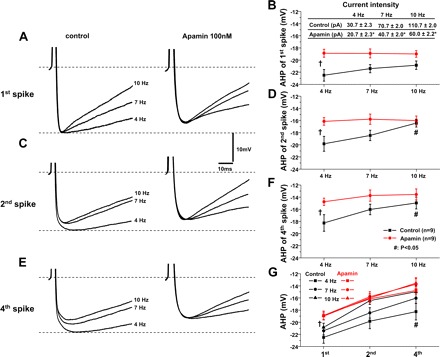Fig. 4.

SK channels regulate spike frequency-dependent AHP in AP trains. A: in 4-, 7-, and 10-Hz AP trains, the AHP peak amplitude of the first spike in these trains was comparable (A, left, B). After apamin application, AHP peak amplitude of the first spike was reduced and comparable in these trains (A, right, B). C: in 4-, 7-, and 10-Hz AP trains, the AHP peak amplitude of the second spike significantly decreased in the 10-Hz train compared with that in the 4-Hz train (C, left, D). Apamin reduced the AHP amplitude of the second spike in 4- and 7-Hz trains. In the 10-Hz train, the AHP peak amplitude of the second spike was comparable in control and apamin groups. After apamin, the AHP peak amplitude in all these trains was comparable (C, right, D) (P > 0.05). E: similarly, the AHP amplitude of the fourth spike significantly decreased in the 10-Hz compared with that in the 4-Hz train (C, left, D). Apamin reduced the AHP amplitude of the fourth spike in 4- and 7-Hz trains. In the 10-Hz train, the AHP amplitude of the fourth spike was comparable in control and apamin-treated groups. After apamin, the AHP amplitude in all these trains was comparable. The AHP amplitude of the fourth spike was significantly decreased in the 10-Hz compared with that in the 4-Hz train (E, left, F). G: apamin abolished the frequency dependency of AHP peak amplitude of individual spikes in spike trains. Inset in B, *P < 0.05 apamin vs. control. †ANOVA, P < 0.05 apamin vs. control; #P < 0.05 10 Hz vs. 4 Hz in control.
